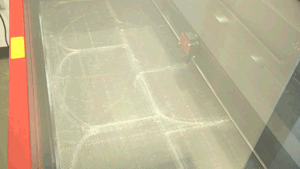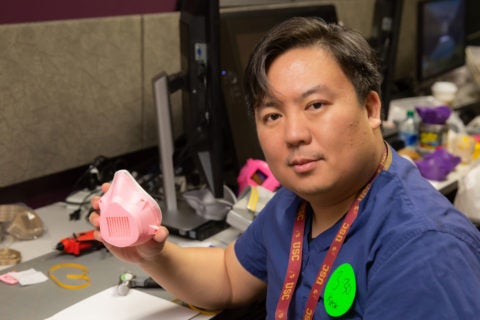USC’s creative makers mobilize garages and shops to protect doctors and nurses through 3D printing
Hundreds of faculty and staff members, students and volunteers are building face shields and respirator masks to answer the call from USC’s medical leaders.
As volunteers mobilize to equip USC’s health care workers with essential protection against the coronavirus, they’re racing against time.
Doctors, nurses, respiratory therapists and other professionals at Keck Hospital of USC, USC Norris Cancer Hospital and USC Verdugo Hills Hospital depend on masks and face shields to stay safe as they treat patients. With the nation facing a shortage, USC’s medical leaders called for help.
USC scientists and engineers responded by diverting existing gear from laboratories to Keck Medicine hospitals, but their effort has grown into a manufacturing push to build new equipment. Hundreds of USC faculty and staff members, students and volunteers turned their homes, garages and workshops into little factories. They build face shields and respirator masks using laser cutters and 3D printers. Their sewing machines churn out medical gowns.
“Almost every fabrication space on campus is trying to contribute. Everybody is trying to figure out the best thing they can make with their facilities,” said Tucker Rae-Grant, digital fabrication lab specialist at the USC Iovine and Young Academy and one of the leaders of the response.
Demand for medical equipment leads to USC schools taking action
Ten days ago, just a couple of masks per day reached Keck Medicine of USC hospitals. Now, about 300 items arrive daily.
But public health experts expect COVID-19 patients to flood into Southern California hospitals over the coming weeks. Keck Medicine estimates it will need 6,000 masks and 6,000 face shields, and that doesn’t include Los Angeles County+USC Medical Center, staffed by Keck School of Medicine faculty physicians.
The demand forced professors across the university — from the USC Viterbi School of Engineering to the USC School of Architecture — to look for new resources and methods to increase production.

At the USC Iovine and Young Academy, a small crew of faculty and students create personal protective equipment (PPE) almost every day while practicing safe social distancing. Staff programmed 10 3D printers to make parts to construct N95-equivalent face masks. They laser-cut and delivered 400 face shields to Keck Medicine last week, and they make parts for respirators and ventilators, too. Los Angeles Mayor Eric Garcetti visited the lab on Sunday, sharing the makers’ work on Facebook Live.
USC School of Architecture faculty got involved as well. Last weekend, Professor Alvin Huang received a message from a colleague at Cornell University, who shared an open-source file for making face masks. Huang shared it on his social media accounts on March 28. Within hours, 40 people had responded. Using the hashtag #OperationPPE, the effort has grown steadily.
“It’s gone viral. It totally snowballed,” he said. “I’m astonished. I did not expect this.”
Huang received calls from Garcetti’s office, news media and fabricators around the world. He led a Zoom conference call with 47 people from Seattle to San Diego. The California chapter of the American Institute of Architects donated $10,000 for materials.
It’s like a war effort. Everyone is collaborating for the greater good.
Victoria Dam
The USC School of Architecture has six 3D printers, but students, faculty and friends have many more. In all, 208 printers have churned out 1,228 N95-equivalent face masks and 655 face shields in less than one week, Huang said. The equipment goes to Keck Medicine, USC+LAC Medical Center, Children’s Hospital Los Angeles and Martin Luther King Jr. Community Hospital in Willowbrook.
“It’s like a war effort. Everyone is collaborating for the greater good,” architecture graduate student Victoria Dam said. “It’s a really good opportunity for [architecture students] to use skills we learn in class and manage material sourcing, mass production and project organizing,” she said.
From making face shields to sewing masks, USC schools find ways to help
At the USC Viterbi School of Engineering, Professor Andrea Armani started by emptying the nanofabrication laboratory she oversees to donate safety glasses, face shields and other protective gear.
“We basically cleaned out all the shelves and filled up boxes,” said Armani, who holds the Ray Irani Chair in Chemical Engineering and Materials Science at USC Viterbi. Then she moved into making face shields and devices to sterilize equipment, documenting their progress on Twitter.
Doubling our production of #faceshields. pic.twitter.com/qfdmlH19fa
— Prof. Andrea Armani (@ProfArmani) April 4, 2020
Even outside 3D printing, artists and creators from the USC School of Dramatic Arts and the USC Roski School of Art and Design helped by sewing gowns and masks.
“We’re all trying our best to help our schools,” said Satyandra K. Gupta, professor of aerospace and mechanical engineering and computer science at USC Viterbi. “This is the Trojan Family coming together to make sure we can take care of each other best we can.”

In some ways, the mobilization began with Darryl Hwang, assistant professor of research for radiology at the Keck School of Medicine and of biomedical engineering at USC Viterbi. When he saw plans online to make face shields and masks, he reached out to USC colleagues and started an equipment fabrication tidal wave. Since then, he’s been contacted by people across California, the United States and South America who want to learn to make PPE for their local hospitals. Businesses also joined in.
“It’s going well,” Hwang said. “We have lots of 3D printers and people with printers. Our ask now is to produce as much as we can. We’re bringing in the Trojan Family to see how we can solve the problem.”
Hwang said that Keck Medicine hospitals have enough PPE for now, but that probably won’t last unless they get new supplies soon. That’s why they’re asking for help.
“The U.S. Centers for Disease Control and Prevention says doctors would have to use bandanas or scarves if facemasks are not available. We’re trying to prepare in case we don’t get resupplied,” he said.
The challenges in pivoting to create medical equipment
Ramping up production to meet demand has its challenges.
Online designs for equipment had to be modified to provide proper protection, he said. Fabricators also face competition from other U.S. hospitals for materials needed to make equipment, such as filament for 3D printers. Volunteers struggle to cover costs of materials and rent for workspaces, often paying for supplies themselves.
The 3D printers are slow, too. One spool of filament costs about $30 and produces about a dozen masks, each of which takes three and a half hours to make, a challenge when scaling production to meet needs.
The equipment isn’t necessarily medical-grade quality. “It’s like wartime medicine,” Huang said. “We’re making pseudo-N95 anti-viral masks. They are not as good as the certified, medical-grade N95 masks, but they’re better than a bandana.”
But these problems are not surprising. New ventures that begin suddenly experience growing pains. As the director of USC Viterbi’s Center for Advanced Manufacturing, Gupta understands this better than most. His lab and the Viterbi/Dornsife Machine Shop help manufacture PPE. The Center for Advanced Manufacturing also plays an important role as matchmaker, leveraging its industry and university contacts to support the needs of Keck Medicine.
Gupta gets students involved as well. The graduate students in one of his courses — AME 546, “Design for Manufacturing and Assembly” — will begin a new project this week: They’ll design a ventilator for critically ill COVID-19 victims.
“Crisis is a time when engineers can be really creative and innovative and make advances quickly,” he said. “We’ve seen that throughout history. We are all trying to do our best to help.”
Eric Lindberg contributed to this story.



